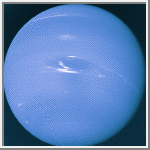 Neptune is the outermost planet of the gas giants. It has an equatorial
diameter of 49,500 kilometers (30,760 miles). If Neptune were hollow,
it could contain nearly 60 Earths. Neptune orbits the Sun every 165
years. It has eight moons, six of which were found by
Voyager. A day on Neptune is 16
hours and 6.7 minutes. Neptune was discovered on September 23, 1846
by Johann Gottfried Galle, of the Berlin
Observatory, and Louis d'Arrest, an astronomy student, through
mathematical predictions made by Urbain Jean Joseph Le Verrier.
Neptune is the outermost planet of the gas giants. It has an equatorial
diameter of 49,500 kilometers (30,760 miles). If Neptune were hollow,
it could contain nearly 60 Earths. Neptune orbits the Sun every 165
years. It has eight moons, six of which were found by
Voyager. A day on Neptune is 16
hours and 6.7 minutes. Neptune was discovered on September 23, 1846
by Johann Gottfried Galle, of the Berlin
Observatory, and Louis d'Arrest, an astronomy student, through
mathematical predictions made by Urbain Jean Joseph Le Verrier.
The first two thirds of Neptune is composed of a mixture of molten rock, water, liquid ammonia and methane. The outer third is a mixture of heated gases comprised of hydrogen, helium, water and methane. Methane gives Neptune its blue cloud color.
Neptune is a dynamic planet with several large, dark spots reminiscent of Jupiter's hurricane-like storms. The largest spot, known as the Great Dark Spot, is about the size of the earth and is similar to the Great Red Spot on Jupiter. Voyager revealed a small, irregularly shaped, eastward-moving cloud scooting around Neptune every 16 hours or so. This scooter as it has been dubbed could be a plume rising above a deeper cloud deck.
Long bright clouds, similar to cirrus clouds on Earth, were seen high in Neptune's atmosphere. At low northern latitudes, Voyager captured images of cloud streaks casting their shadows on cloud decks below.
The strongest winds on any planet were measured on Neptune. Most of the winds there blow westward, opposite to the rotation of the planet. Near the Great Dark Spot, winds blow up to 2,000 kilometers (1,200 miles) an hour.
Neptune has a set of four rings which are narrow and very faint. The rings are made up of dust particles thought to have been made by tiny meteorites smashing into Neptune's moons. From ground based telescopes the rings appear to be arcs but from Voyager 2 the arcs turned out to be bright spots or clumps in the ring system. The exact cause of the bright clumps is unknown.
The magnetic field of Neptune, like that of Uranus, is highly tilted at 47 degrees from the rotation axis and offset at least 0.55 radii (about 13,500 kilometers or 8,500 miles) from the physical center. Comparing the magnetic fields of the two planets, scientists think the extreme orientation may be characteristic of flows in the interior of the planet and not the result of that planet's sideways orientation or of any possible field reversals at either planet.